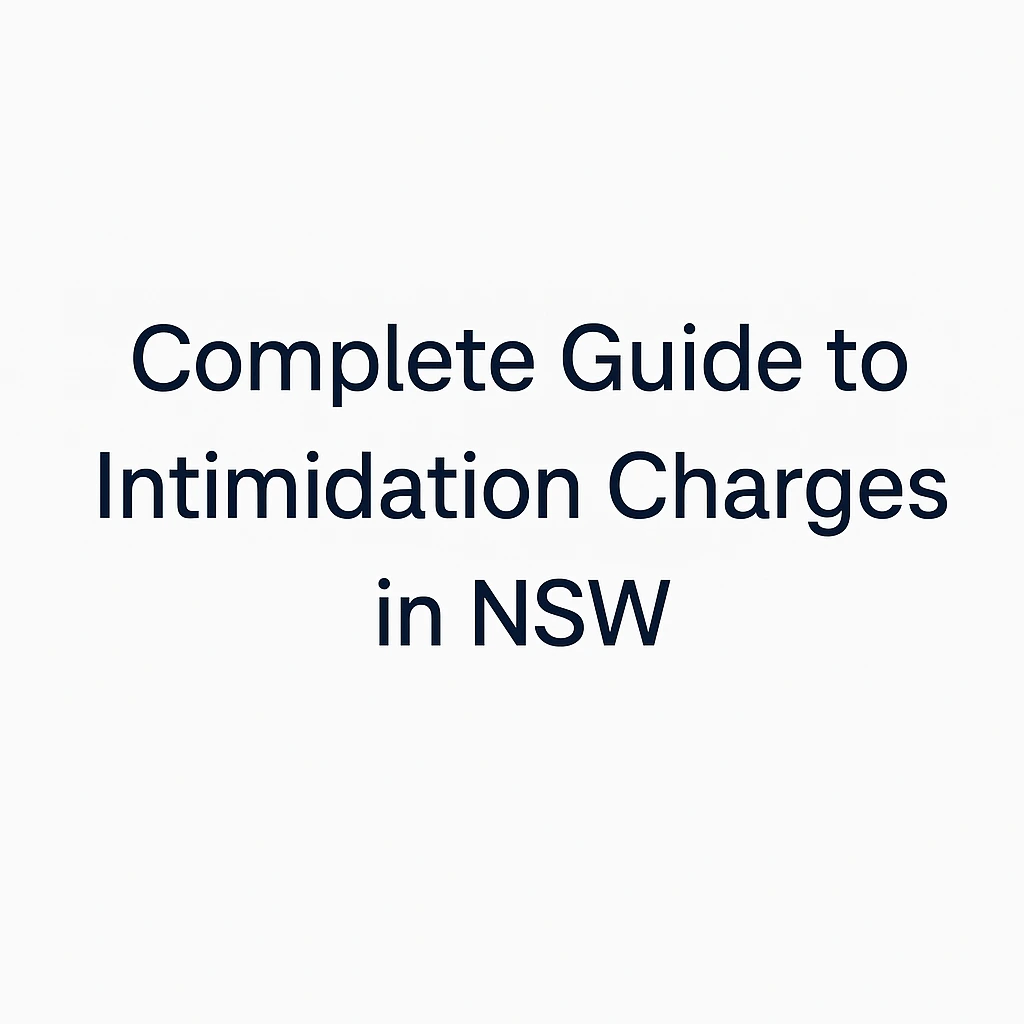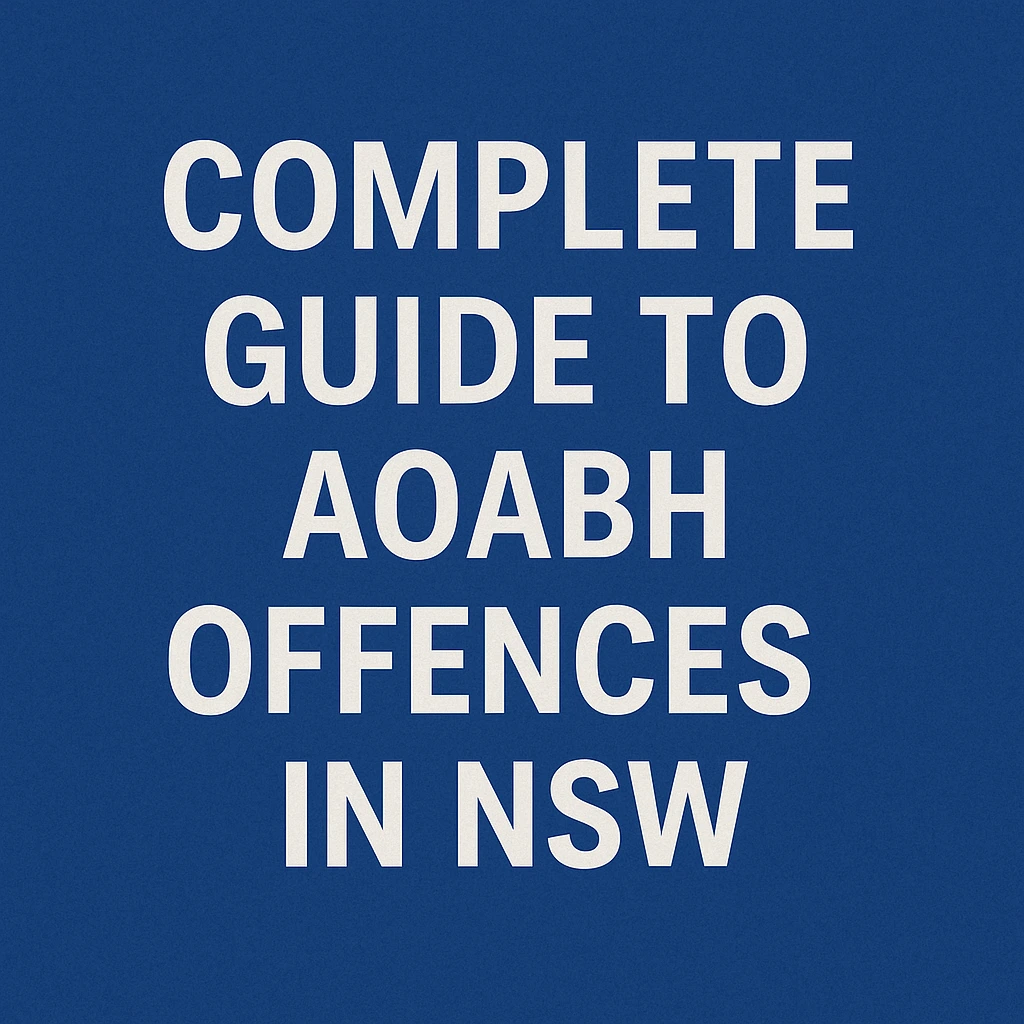Intimidation Charges in NSW
Being accused of intimidation is a serious matter. A NSW intimidation charge indicates you are alleged to have intimidated someone with the intent to cause fear of harm. This comprehensive guide explains what is intimidation charge under NSW law, the legal definition of intimidation, how the charge can be proven, the penalties (including any intimidation charge NSW minimum sentencing considerations), possible defences, and what to do if you are charged with intimidation.
What Is an Intimidation Charge in NSW?
An intimidation charge in NSW refers to the offence of “intimidate with intent to cause fear of physical or mental harm” under Section 13(1) of the Crimes (Domestic and Personal Violence) Act 2007 (NSW).
Many people facing charges ask themselves, what is intimidation charge? In simple terms, an intimidation charge means police allege you engaged in behaviour that harasses, threatens or frightens someone, intending to make them fear for their safety. Importantly, this section covers both “intimidation” and “stalking” conduct:
- Intimidation includes harassment, threats or any conduct that causes a person to fear injury or violence to themselves, someone close to them, or their property. It can involve approaching or contacting someone (even via calls, texts, or online) in a way that causes fear for their safety. Even acts like repeated unwanted phone calls or cyberbullying can amount to intimidation under the law.
- Stalking includes following someone, watching or loitering near their home or work, or contacting them via the internet or other technology. In other words, any pattern of surveillance or unwanted proximity that could terrify the person may be considered stalking.
The offence is often referred to simply as “intimidation”. The law focuses on the intent to cause fear. You can be charged with intimidation even if no physical harm was done – what matters is that your conduct could cause a reasonable person to fear injury or harm. The prosecution does not have to prove the victim actually felt scared, only that you intended to make them fear harm. Also, an attempt to intimidate (e.g. an unsuccessful effort to frighten someone) is treated the same as if the offence had been completed.
Context: Intimidation charges frequently arise in domestic or personal relationship contexts, but they are not limited to domestic violence situations. The law explicitly says causing a person to fear for the safety of someone with whom they have a domestic relationship also counts as intimidation. This means threatening someone’s family or partner is included. Due to the link with domestic violence, NSW police and courts take NSW intimidation charge cases very seriously. In fact, intimidation is classified as a “serious indictable offence” (punishable by five years imprisonment), though it is usually dealt with in the Local Court.
How Does the Law Define “Intimidation” in NSW?
The legal definition of intimidation in NSW is quite broad. Under Section 7 of the Crimes (Domestic and Personal Violence) Act 2007, “intimidation” of a person can include a range of behaviours:
- Harassment or molestation: Ongoing conduct that harasses, pesters or torments the person. For example, repeatedly sending unwanted messages or following them around can be harassment.
- Threatening approaches: Any approach made by any means (in person, phone, text, email, social media, etc.) that causes the person to fear for their safety.
- Causing apprehension of injury or violence: Any conduct that leads a reasonable person to fear that someone might be injured, subjected to violence, or that property might be damaged. Even without an explicit threat, actions like aggressively yelling at someone, smashing objects in their presence, or driving by their house repeatedly could cause this fear.
These definitions mean that a wide array of behaviours – physical, verbal, or digital – can amount to intimidation if they create fear. For instance, sending dozens of unwanted texts, showing up uninvited at someone’s door every day, or making a threat like “I know where you live” can all lead to an intimidation charge. Examples of intimidation include:
- Persistent unwanted contact: Constantly calling, texting, or emailing someone after they’ve told you to stop.
- Threats of harm: Explicitly threatening to hurt a person or their family, such as saying “I’ll break your arm” or “You’ll pay for this”.
- Menacing behaviour in person: Repeatedly showing up at the person’s home or workplace without permission, following them around, or lurking outside their house.
- Cyberbullying or online harassment: Using social media or other online platforms to post threatening messages, spread personal information (“outing” someone), or to continually harass in a way that causes distress.
Any of these behaviours could result in a NSW intimidation charge if done with the intention to cause fear. Even if the accused person does not anticipate the victim would be afraid, the test is objective: would a reasonable person in the victim’s shoes fear harm? If yes, the conduct can amount to intimidation.
What Must Police Prove to Secure an Intimidation Conviction?
To secure a guilty verdict for an intimidation offence, the prosecution must prove two key elements beyond reasonable doubt:
- Intimidation (conduct): The accused engaged in conduct that amounts to intimidating as defined by the law. This means the actions fit within the broad definitions described above. Evidence could include witness testimony, text message records, social media posts, CCTV footage of the accused following the person, and so on.
- Intent to cause fear of harm: The accused intended to make the person fear physical or mental harm. In legal terms, the person must have meant to scare the victim (or at least knew their conduct was likely to cause fear). This intent can be inferred from the circumstances – for example, making a death threat clearly shows an intent to cause fear. Notably, the law states that actual fear by the victim is not required; the focus is on the offender’s intent and actions.
These elements together answer the common question, what is intimidation charge from a legal standpoint.
Important nuances:
- The prosecution does not have to show the victim communicated their fear or that they asked the accused to stop. A person can be charged with intimidation even if the victim never confronted them or called police until later. What matters is the accused’s behaviour and intent.
- No actual injury or assault is required. Intimidation is often about psychological harm. There may be overlapping charges (for example, if an assault or property damage occurred, those could be charged separately), but intimidation itself focuses on causing fear of harm. You could face an intimidation charge for pointing a toy gun at someone as a prank, if they reasonably believed it was real and you meant harm – because you caused fear, even though no one was physically hurt.
In summary, to prove the charge, police must prove that “Person A intimidated Person B, and Person A meant to make Person B fear injury or harm.” All elements must be proven beyond reasonable doubt, which is the highest standard in criminal law (the court must be certain of guilt). If there is any reasonable doubt about either element – for instance, if it’s unclear what the accused did or why they did it – then the court must not convict.
Penalties for an Intimidation Charge in NSW
Maximum Penalty: Intimidation is punishable by up to 5 years imprisonment or a fine of up to 50 penalty units. This is the maximum penalty set by Section 13 of the Act – it represents the upper-end punishment for the most serious instances of the offence. Courts reserve the maximum penalty for the worst kind of offending (for example, a prolonged campaign of intimidation with threats of extreme violence).
For less severe matters, courts often impose penalties below the maximum, and understanding the intimidation charge NSW minimum consequences can help you prepare for sentencing.
It’s important to note there is no mandatory minimum sentence specified in the legislation for an intimidation offence. In other words, there is no fixed intimidation charge NSW minimum jail term or fine that must be imposed. Judicial officers have discretion to choose an appropriate sentence based on the circumstances. This means the penalty can range widely:
- For relatively minor or first-time offences, the court might impose a lesser sentence – potentially a Conditional Release Order without conviction, or even a Section 10 dismissal (no conviction) if the offence on the lower end of objective seriousness. In some cases, offenders may receive non-conviction orders or community-based sentences for intimidation, especially if they have no prior record and the conduct was at the lower end of seriousness.
- For more severe cases – for example, where there were explicit death threats, use of weapons to instil fear, or a history of similar conduct – the court will consider harsher penalties, including imprisonment.
In short, while there’s no automatic intimidation charge NSW minimum sentence, courts often impose a community-based penalty or fine, and sometimes imprisonment sentences if warranted.
Ancillary Orders: In almost every case involving intimidation (especially domestic-related), the court will also make a final Apprehended Violence Order (AVO) to protect the victim. An AVO is a separate order that can place restrictions on the offender (for example, not to approach or contact the victim). Breaching an AVO is a criminal offence on its own. So, if you are facing an intimidation charge, you will likely also face an AVO application. Even if the criminal charge is dealt with leniently, the AVO can remain in force for years to protect the person intimidated.
Which Court Will Hear the Case?
Intimidation charges are usually prosecuted summarily in the Local Court (before a Magistrate). The offence is classified as indictable, but it’s one that can be finalised by a Local Court with a maximum jurisdictional limit of 2 years imprisonment per charge (if dealt with summarily). In practice, most cases stay in Local Court.
In the District Court, a Judge (and jury if a trial) would handle the case, and the full range of penalties (up to 5 years) applies. For most people, though, facing a NSW intimidation charge means going to the Local Court nearest where the offence happened.
Defences to an Intimidation Charge
Understanding what is intimidation charge is the first step in preparing a strong defence. Being charged with intimidation does not mean automatically a conviction – you have the right to defend the charge in court. There are several defences that may apply, depending on the facts:
- No Intimidation Occurred: You can argue that the alleged acts never occurred or do not amount to intimidation as defined by law. For example, if you’re accused of making threats but the evidence is weak and sparse, the prosecution might fail to prove the conduct occurred.
- Lack of Intent: Even if the acts occurred, you may contend that you never intended to cause fear. Maybe the behaviour was misinterpreted – for instance, you sent multiple messages not to scare the person but to apologise.
- Acts Not Reasonably Fear-Inducing: The law requires the conduct to be such that it would cause a reasonable person to apprehend harm. If the evidence shows that the complainant’s fear was not reasonable or that an ordinary person would not have felt threatened by the conduct, it might lead to an acquittal.
- False Allegation: Sadly, in some disputes, people do make false or exaggerated claims. A defence may require proving that the complainant’s story is inconsistent, lacks evidence, or is motivated by an ulterior motive.
- Lawful Authority or Excuse: Some intimidation charges may be defended by showing the conduct was lawful or had a reasonable excuse. For instance, a security guard who loudly orders a trespasser to leave, causing them fear, might be lawfully authorised to do so.
Each case is unique, and the availability of defences will vary. Successfully defending an intimidation charge often comes down to the evidence. It’s crucial to gather any proof that supports your version of events – this could include text message logs, emails, CCTV footage, witness statements, or other records.
Facing an Intimidation Charge: Next Steps and Getting Help
If you have been charged with intimidation in NSW, it’s natural to feel anxious about what comes next. Here are some steps and considerations to help you navigate the situation:
- Comply with Any Orders: Upon charging you, police may also issue an Apprehended Violence Order. Read it carefully and comply fully with its conditions.
- Bail Conditions: If you’ve been released on bail, make sure you understand and follow all bail conditions.
- Gather Evidence and Documents: Start collecting anything relevant to the incidents. Save texts, emails, call logs, screenshots of social media – both what you sent and what the complainant sent (if any). Write down a detailed account of your memory of events while it’s fresh. Identify any witnesses who saw interactions between you and the other person. All this will assist your solicitor.
- Legal Advice: Most importantly, consult an experienced Blacktown criminal lawyer as soon as possible.
Contact AMA Legal
Facing an intimidation charge can be overwhelming, but you don’t have to go through it alone. AMA Legal has extensive experience defending clients against intimidation charge allegations in NSW. Contact AMA Legal today for a confidential consultation. We will explain your options clearly and help you navigate the process every step of the way.





